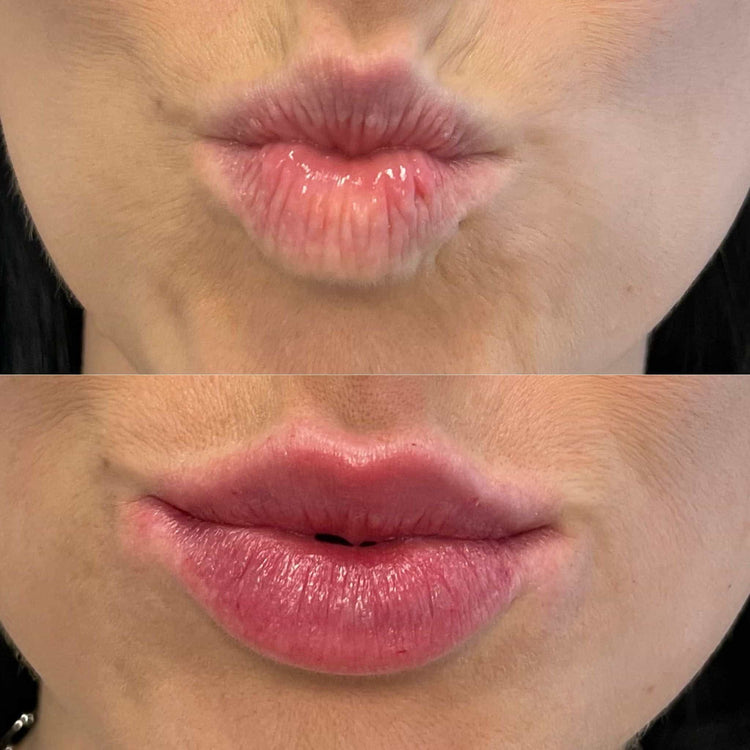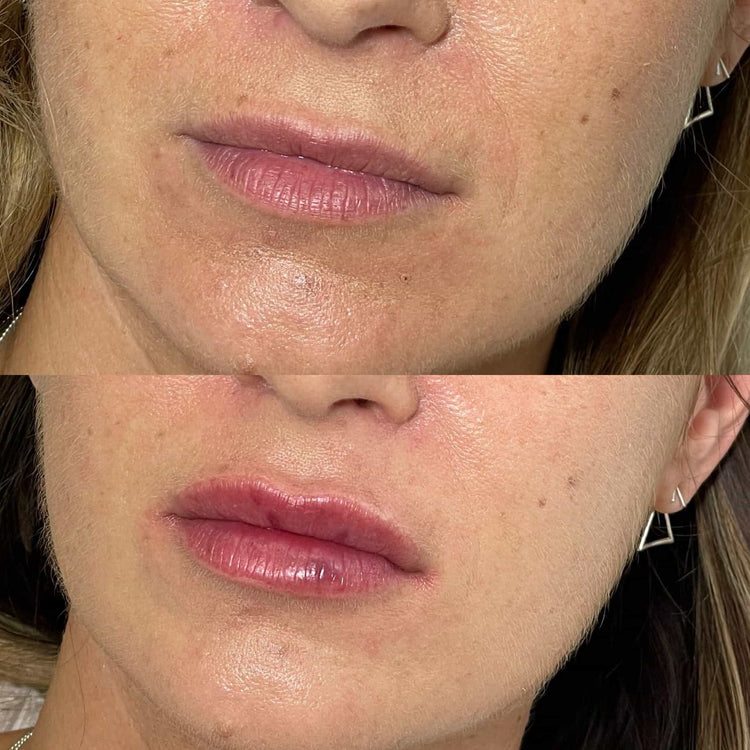Filler Dissolving vs. Touch-Up: Key Differences
For those seeking to modify or refine their lip augmentation, understanding the distinct differences between filler dissolving and touch-up treatments is crucial. While both aim to address aspects of lip fillers, they serve different purposes and involve unique procedures. Filler dissolving targets the removal of existing filler, offering a complete reversal of previous enhancements, while touch-ups focus on maintaining and enhancing current results by adding more product.
Substance Used
Filler dissolving is used when someone wants to completely remove existing lip fillers. A special enzyme called hyaluronidase is injected into the lips to break down the hyaluronic acid in the filler, causing it to be absorbed by the body. This process effectively reverses the effects of previous lip augmentation treatments.
In contrast, a touch-up involves adding more filler to already treated lips. It’s used to maintain the desired shape and volume, or to make subtle adjustments as the original filler gradually dissipates over time. During a touch-up, additional hyaluronic acid filler is injected, building upon the existing structure.
Procedure Duration
Filler dissolving and lip filler touch-ups are distinct procedures aimed at achieving different outcomes. Filler dissolving aims to completely remove existing lip fillers, essentially reversing previous augmentation. This process involves injecting hyaluronidase, an enzyme that breaks down hyaluronic acid, the component of most lip fillers. The body then absorbs this broken-down hyaluronic acid.
Touch-ups, on the other hand, focus on enhancing and maintaining existing lip filler results. When original filler gradually dissipates over time, a touch-up involves injecting additional hyaluronic acid to replenish volume and preserve the desired shape.
Cost
Filler dissolving and touch-ups both address lip filler concerns but with distinct approaches.
Filler dissolving aims to completely remove existing lip filler. A special enzyme called hyaluronidase is injected to break down the hyaluronic acid in the filler, allowing the body to absorb it. This provides a complete reversal of previous augmentation.
Touch-ups, conversely, focus on maintaining and enhancing current results. As original filler gradually dissipates over time, a touch-up involves injecting more hyaluronic acid filler to replenish volume and preserve the desired shape.
The cost of filler dissolving generally exceeds that of a touch-up. Dissolving requires the use of hyaluronidase, which adds to the overall expense. Touch-ups, being less invasive and requiring less product, are typically more budget-friendly.
Effects on Existing Filler
Filler dissolving is used when someone wants to completely remove existing lip fillers. A special enzyme called hyaluronidase is injected into the lips to break down the hyaluronic acid in the filler, causing it to be absorbed by the body. This process effectively reverses the effects of previous lip augmentation treatments.
In contrast, a touch-up involves adding more filler to already treated lips. It’s used to maintain the desired shape and volume, or to make subtle adjustments as the original filler gradually dissipates over time. During a touch-up, additional hyaluronic acid filler is injected, building upon the existing structure.
Filler dissolving and lip filler touch-ups are distinct procedures aimed at achieving different outcomes. Filler dissolving aims to completely remove existing lip fillers, essentially reversing previous augmentation. This process involves injecting hyaluronidase, an enzyme that breaks down hyaluronic acid, the component of most lip fillers. The body then absorbs this broken-down hyaluronic acid.
Touch-ups, on the other hand, focus on enhancing and maintaining existing lip filler results. When original filler gradually dissipates over time, a touch-up involves injecting additional hyaluronic acid to replenish volume and preserve the desired shape.
The cost of filler dissolving generally exceeds that of a touch-up. Dissolving requires the use of hyaluronidase, which adds to the overall expense. Touch-ups, being less invasive and requiring less product, are typically more budget-friendly.
Results
Filler dissolving and lip filler touch-ups are distinct procedures aimed at achieving different outcomes. Filler dissolving aims to completely remove existing lip fillers, essentially reversing previous augmentation. This process involves injecting hyaluronidase, an enzyme that breaks down hyaluronic acid, the component of most lip fillers. The body then absorbs this broken-down hyaluronic acid.
Touch-ups, on the other hand, focus on enhancing and maintaining existing lip filler results. When original filler gradually dissipates over time, a touch-up involves injecting additional hyaluronic acid to replenish volume and preserve the desired shape.
The cost of filler dissolving generally exceeds that of a touch-up. Dissolving requires the use of hyaluronidase, which adds to the overall expense. Touch-ups, being less invasive and requiring less product, are typically more budget-friendly.
Recovery Time
Filler dissolving and lip filler touch-ups serve different purposes in lip augmentation. Filler dissolving aims to completely remove existing lip fillers, effectively reversing previous enhancements. A special enzyme called hyaluronidase is injected to break down the hyaluronic acid in the filler, allowing the body to absorb it naturally.
In contrast, a touch-up focuses on maintaining and enhancing the current results of lip augmentation. As the original filler gradually dissipates over time, a touch-up involves injecting more hyaluronic acid filler to replenish volume and preserve the desired shape.

The recovery time for filler dissolving is typically shorter than for a touch-up. Since it involves breaking down existing filler, there may be some swelling and bruising initially, but these usually subside within a few days. Touch-ups, on the other hand, can involve some temporary swelling and redness, which might last a bit longer.
The cost of filler dissolving is generally higher than a touch-up. Dissolving requires the use of hyaluronidase, an additional expense compared to a touch-up, which utilizes only the hyaluronic acid filler.
Long-Term Considerations
For those considering modifications to their lip augmentation, understanding the nuances between filler dissolving and touch-up treatments is crucial. While both aim to address aspects of existing lip fillers, they serve distinct purposes and involve unique procedures.
Risks and Side Effects
Filler dissolving carries long-term considerations that differ from touch-ups. While touch-ups simply add more product to maintain the desired shape and volume, dissolving completely removes existing filler. This means individuals considering dissolving should think about whether they desire a complete return to their pre-filler lip appearance or are open to future adjustments.
Both procedures carry potential risks and side effects. Dissolving can lead to uneven results if not administered carefully, potentially requiring further treatment or touch-ups to achieve symmetry. Touch-ups also carry risks of swelling, bruising, and infection, although these are generally less severe than those associated with dissolving.
Long-term, both procedures may affect the skin’s natural structure and elasticity over time. Repeated injections, whether for dissolving or touch-ups, can potentially contribute to collagen degradation, making future adjustments more challenging. It is crucial to consult with a qualified medical professional to discuss individual risk factors and weigh the potential benefits and drawbacks of each procedure before making a decision.

Suitability for Future Fillers
Filler dissolving carries long-term considerations that differ from touch-ups. While touch-ups simply add more product to maintain the desired shape and volume, dissolving completely removes existing filler. This means individuals considering dissolving should think about whether they desire a complete return to their pre-filler lip appearance or are open to future adjustments.
The suitability of future fillers depends on the individual’s goals and the results achieved through dissolving. If complete removal is desired, future touch-ups may be necessary to achieve desired volume and shape again. However, repeated dissolving treatments could potentially impact the lips’ natural structure and elasticity over time.
Ultimately, a thorough consultation with a qualified medical professional is essential to assess individual suitability for both dissolving and future filler treatments, considering long-term goals and potential risks.
Enquire about filler dissolving services at It’s Me & You Clinic with Dr. Laura Geige.
- Filler For Volume Loss In Epsom, Surrey - September 29, 2025
- Downturned Smile Treatment Near Seale, Surrey - September 27, 2025
- Is Sculptra The Best Treatment For Collagen Boosting In Surrey - September 26, 2025
